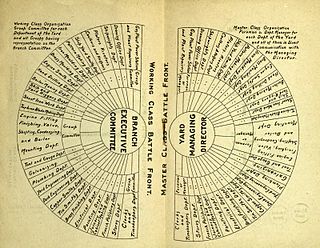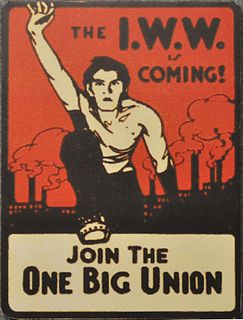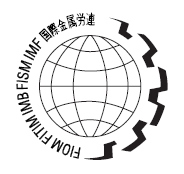Related Research Articles

Industrial unionism is a trade union organizing method through which all workers in the same industry are organized into the same union, regardless of skill or trade, thus giving workers in one industry, or in all industries, more leverage in bargaining and in strike situations.

The Workers' Commissions since the 1970s has become the largest trade union in Spain. It has more than one million members, and is the most successful union in labor elections, competing with the Unión General de Trabajadores (UGT) (historically affiliated with the Spanish Socialist Workers' Party, and with the anarcho-syndicalist Confederación General del Trabajo, which is usually a distant third.

The One Big Union was an idea in the late 19th and early 20th centuries amongst trade unionists to unite the interests of workers and offer solutions to all labour problems.

The World Confederation of Labour (WCL) was an international labour organization founded in 1920 and based in Europe. Totalitarian governments of the 1930s repressed the federation and imprisoned many of its leaders, limiting operations until the end of World War II. In 2006 it became part of the International Trade Union Confederation (ITUC), ending its existence as an independent organization.

The International Metalworkers' Federation (IMF) was a global union federation of metalworkers' trade unions, founded in Zürich, Switzerland in August 1893. As of 2009, the IMF had more than 200 member organisations in 100 countries, representing a combined membership of 25 million workers.
Timeline of trade union history

The Workers' Unity League (WUL) was established in January 1930 as a militant industrial union labour central closely related to the Communist Party of Canada on the instructions of the Communist International.
The Organisation of African Trade Union Unity (OATUU) is an independent regional union federation aimed at unifying trade union centres in Africa. This organisation was founded in April, 1973 as a successor to two previously competing labour union organisations in Africa: the All-African Trade Union Federation (AATUF) and the African Trade Union Confederation (ATUC). The process to unify a Pan-African labour union organisation also involved international labour organisations as decision-making stakeholders like the International Confederation of Free Trade Unions (ICFTU) and the World Federation of Trade Unions (WFTU). Finally, also with the help of the Organisation of African Unity (OAU), the AATUF and the ATUC merged to form the OATUU. The driving factors for this unification and the creation of the OATUU was to advance Pan-Africanism, economic justice, and social justice throughout African workplaces.

The International Trade Union Confederation (ITUC) is the world's largest trade union federation.

The Federation of South African Trade Unions (FOSATU) was a trade union federation in South Africa.
The trade unions of Tanzania have a total membership of approximately 370,000. 350,000 of these belong to the Trade Union Congress of Tanzania, another 15,000 to the Zanzibar Trade Union Congress, and 2,400 are members of the Tanzania Fishing Crew and Allied Workers’ Union.

International Workers' Day, also known as Labour Day in some countries and often referred to as May Day, is a celebration of labourers and the working classes that is promoted by the international labour movement and occurs every year on May Day.
The South African Trades Union Congress (TUC) was a national trade union federation in South Africa.
The South African Congress of Trade Unions (SACTU) was a national trade union federation in South Africa.
The Labor Congress of Liberia was a trade union centre in Liberia. It was one of the precursors of the Liberian Federation of Trade Unions (LFTU).
The Liberian Federation of Trade Unions was a trade union centre in Liberia.
Amos N. Gray was a Liberian trade unionist. Born in Pull River, Maryland County, Gray attended primary school in Pull River and secondary school in Harper. He attended college in Monrovia, studying social studies for two years and law for one year. During his college years he worked part-time at the Freeport of Monrovia. Working at the port in 1960, he joined the Maritime and Dock Workers Union. After his college years he worked at the Maritime and Dock Workers Union office in Monrovia.
Trade unions in South Sudan first emerged in the period prior to the country's independence with the formation of the Southern Sudan Workers Trade Union in August 2010.
References
- ↑ William D. Coale (1978). West German Transnationals in Tropical Africa: The Case of Liberia and the Bong Mining Company. Boston University. p. 201. ISBN 978-3-8039-0165-1.
- ↑ Worldmark Encyclopedia of the Nations. Gale Research. 1976. p. 162.
- 1 2 3 4 Liberia-forum. Liberia Working Group. 1988. pp. 37–38, 41.
- ↑ Record of Proceedings -International Labour Conference. International Labour Office. 1975. p. xlviii.
- ↑ Africa Year Book and Who's who. Africa Journal Limited. 1977. p. 528.
- 1 2 H. Boima Fahnbulleh (2004). Voices of Protest: Liberia on the Edge, 1974-1980. Universal-Publishers. p. 144. ISBN 978-1-58112-503-0.
- 1 2 3 A. P. Coldrick; Philip Jones (1979). The international directory of the trade union movement. Macmillan. p. 297.
- ↑ Organisation of African Trade Union Unity (1976). Second Congress of the OATUU, Tripoli, Libya, 20-23, April, 1976: preamble. The Congress. p. 31.
- ↑ Elwood D. Dunn; Amos J. Beyan; Carl Patrick Burrowes (20 December 2000). Historical Dictionary of Liberia. Scarecrow Press. p. 199. ISBN 978-1-4616-5931-0.
- ↑ Martin Upham (1991). Trade Unions of the World. Longman Group UK Limited. p. 286.